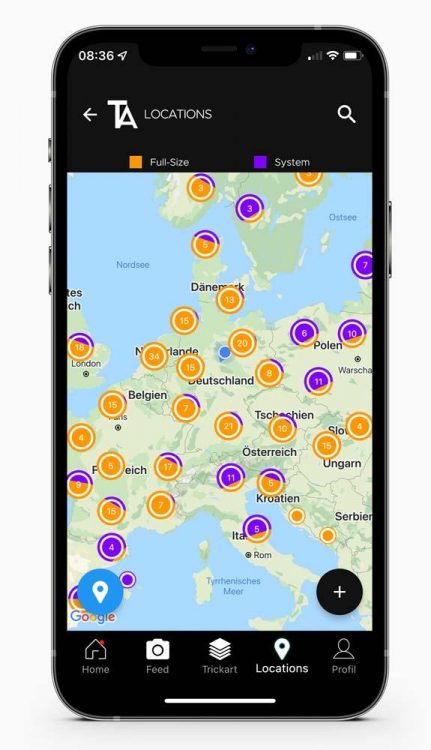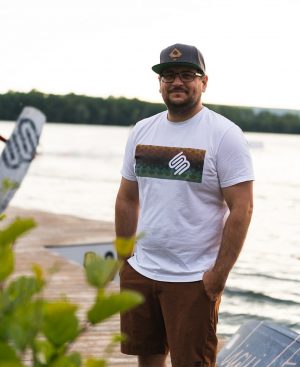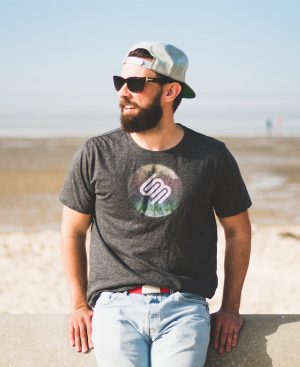Purchase Advice Wakeboard
Wakeboarding is becoming increasingly popular in german-speaking countries. The nice thing about this sport is, that it can be practiced in many places, unlike other water sports like surfing. The places are called cable parks. In Germany, Austria and Switzerland there are a huge number of cable parks for wakeboarders and water skiers. Wakeboarding behind a boat is also possible.
Topic overview
Where you can go wakeboarding?
This entirely depends on your preferred wakeboarding style. There are two types of wakeboarding: cable park wakeboarding and boat wakeboarding. The name “Cable Park Wakeboarding” is self-explanatory: you are pulled across the lake with the support of a rope. The system works in a similar way to a ski lift, only faster and in a circle. Wakeboards that were developed for cable parks usually have more flex (flexibility), a smooth bottom side (underwater ship) and removable (or non-existent) fins.
Boat wakeboarding involves being pulled by a powerful motorboat. Stiffer boards with less flex are required for this type of riding. The classic boat wakeboard has so-called “moulded in” fins, which are permanently installed in the board. With attachable fins, however, the board can be used for both styles.
What do you need for wakeboarding?
It doesn’t take much to stand on a wakeboard for the first time as a beginner. It is best to find a wakeboard park on the internet where you can try wakeboarding for the first time. For two hours of wakeboarding you can expect to pay around 20 – 30 €, plus rental fees for the board, wetsuit, helmet and life jacket.
If you notice that wakeboarding inspires you and you want to stand on the board more often in the future, it makes sense to buy the items. On the one hand you save money on rent, but on the other hand you have a board you are used to. A high-quality wakeboard costs around 600 €, plus a helmet for around 50 € and a life jacket or impact protection vest for around 75 – 100
It doesn’t take much to stand on a wakeboard for the first time as a beginner. It is best to find a wakeboard park on the internet where you can try wakeboarding for the first time. For two hours of wakeboarding you can expect to pay around €20-30, plus rental fees for the board, wetsuit, helmet and life jacket.
If you notice that wakeboarding inspires you and you want to stand on the board more often in the future, it makes sense to buy the items. On the one hand you save money on rent, but on the other hand you have a board you are used to. A high-quality wakeboard costs around €600, plus a helmet for around €50 and a life jacket or impact protection vest for around €75-100 €. Most resorts also offers a seasonal or annual pass, so you can count on discounts here too.. Most resorts also offers a seasonal or annual pass, so you can count on discounts here too.

Unser Tipp
Mit der kostenlosen App “Trick Art” kannst Du dir alle Locations zum Wakeboarden anzeigen lassen und bekommst Informationen zu den Anlagen.
What length for a wakeboard?
The length of the wakeboard is the most important factor to consider when making your choice. Your height, but above all your weight, is used to determine this measurement.
Recommended lengths for different weight classes are listed in the table below.
Please note that these are only “guidelines” that in reality may differ from rider to rider or depend on the experience and wishes of the different riders.
Männer / Men
Gewicht Rider (Kg) | Boardlänge (cm) |
10 Kg – 30 Kg | 111 cm – 120 cm |
18 Kg – 40 Kg | 118 cm – 130 cm |
30 Kg – 50 Kg | 124 cm – 134 cm |
50 Kg – 70 Kg | 134 cm – 138 cm |
65 Kg – 75 Kg | 136 cm – 139 cm |
75 Kg – 85 Kg | 137 cm – 143 cm |
85 Kg – 100 Kg + | 142 cm – 146 cm |
95 Kg – 125 Kg + | 150 cm – 155 cm |
Frauen / Women
Gewicht Rider (Kg) | Boardlänge (cm) |
10 Kg – 30 Kg | 111 cm – 118 cm |
18 Kg – 40 Kg | 118 cm – 129 cm |
30 Kg – 40 Kg | 124 cm – 130 cm |
40 Kg – 55 Kg | 130 cm – 133 cm |
55 Kg – 65 Kg | 132 cm – 136 cm |
65 Kg – 70 Kg + | 136 cm – 139 cm |
The current trend is clearly towards longer wakeboards. Longer boards are preferred by many wakeboarders (both beginners and experts) and cable park fans. What is the reason for that? With longer boards you have some advantages in the modern style (cable park with obstacles). On the one hand you have more buoyancy in the water due to the larger surface of the board and you need less power when driving. On the other hand, you have a better and safer grip on obstacles and when landing.
Smaller wakeboards are more playful to ride. The shorter length makes it easier to turn and make smaller turns. However, with a smaller board you lie deeper in the water and have to use more force. If you are at an advanced level and want to jump so-called air tricks, a smaller board is again an advantage.
As you can see, the choice of length is of particular importance and can vary depending on the application and your style. Especially at the beginning it is advisable to buy a slightly longer wakeboard.
Wakeboard with channels?
Channels are a sometimes popular but not necessary feature of a wakeboard. Channels are small channels on the bottom side of the board and are intended to provide stability when riding and landing, similar to fins. In theory, channels are especially recommended for beginners. Practice shows, however, that (whether beginner or advanced) everyone has their own preferences.
Basically, channels can provide a little more stability when landing. But they can also hinder you when turning or on the obstacle. Most importantly, channels are less critical when cornering. What matters here is a well-ground (shaped) edge.
Wakeboard with or without fins?
As with many water sports, the fins also provide more guidance and stability with wakeboarding. When these fins are removed, the wakeboard becomes much more agile and is easy to turn. However, this makes the board a little less stable, but this does not matter in the cable wake park. A general distinction is made between integrated (moulded-in) fins, which cannot be removed, and detachable (screw-on) fins, which can be disassembled, replaced, and even repositioned.
Beginners in particular are happy about fins, as they also ensure that you can celebrate more success and do not end up directly with your body in the water. Advanced wakeboarders usually opt for fins when riding behind a boat. Finns are almost a must have here. However, if you’re a fan of the obstacles in the cable park, you’ll have to switch boards anyway as the fins will damage the obstacles. Riding over the obstacles with fins is therefore strictly forbidden.
Which flex suits me?
Flex is an acronym for flexibility and is popping up everywhere in the wakeboarding world. This flexibility can be divided into three levels: soft, medium and hard.
SOFT FLEX
The soft flex is particularly suitable for all wakeboarders who love the obstacles in the cable park. Because the board is now softer, it is easier to bend. This makes it even easier to perform tricks such as pressing on the ends (tip and tail) of the board. Also, those prone to knee pain will appreciate a soft flex board as this will give more on landing than the other two tiers. However, a soft flex board also has a small disadvantage: it doesn’t have the strong pop that medium or hard flex boards do. This makes jumping out of the water more difficult, but of course still feasible.
MEDIUM FLEX
A wakeboard with medium flex is usually the all-rounder. It is soft enough to be able to do many tricks on obstacles. However, it still has enough resilience (pop) so that you can jump out of the water easily and energetically. This flex is definitely recommended for beginners.
HARD FLEX
The hard version, on the other hand, is ideal for all wakeboarders who aim high and enjoy jumping. Of course, experienced riders with a hard flex can also press properly, but beginners might have a hard time with this. For all wakeboarders who like to ride behind a boat, the hard flex is also the best choice.
Why do I need a grindbase?
The grind base on a wakeboard ensures that you don’t have to buy a new board every month. The grindbase is processed on the bottom side of the board and thereby protects your wakeboard from damage and abrasion that can occur from obstacles. Depending on the manufacturer, it consists of a different plastic film and is therefore of different robustness. An important sign of a high quality grind base is that it is fully sintered. In addition, the grind bases of the different manufacturers offer different slip behavior on obstacles. Here you have to test and decide which one you like best.
How long is the warranty on boards?
After you have decided on a board, you should definitely ask yourself what the guarantee and warranty are like. A guarantee is a voluntary service. Many manufacturers advertise with a board for the cable park, but exclude the guarantee when using the obstacles. You have to decide for yourself if you want to take that risk. So ask explicitly about the guarantee on your future board before you buy it.
In addition, you should also inquire about the service. In the case of minor edge damage, some manufacturers and shops will repair the damage for you, while others will not. Since your board is usually heavily used when wakeboarding and can wear out a lot, the guarantee is an important point when buying. In the best-case scenario, you get a twelve-month guarantee on essential damage such as the board breaking or the bindings being torn out.
How long does a wakeboard last?
That basically depends on how often you ride, how you ride and what materials are used in your board. If you’re on the water several times a week and ride a lot of obstacles, your board will probably last less than if you’re only on the water a few times a year. In addition, the nature of the obstacles and the water itself is crucial. If you are in a very sandy lake, there is always a little bit of it on the obstacles. This leads to increased friction and thus faster wear of your board.
You should make sure that your board has a grind base (ideally made of sintered UHMW-PE material). This material is the most durable and protects your board for the longest time compared to other materials. In addition, the edge of your board is of great importance, as your board will probably hit an obstacle more often when practicing. If the edge protrudes a bit from the board (and is at best made of robust poly-urethane), it protects your board for a long time.
As you can see, there are many influencing factors on durability. As a rule, your board should last at least two years with regular use.
Is the edge important?
The edge of your board fulfills two functions. On the one hand, it should protect your board from bumps and, on the other hand, ensure the best possible cornering grip.
A PU edge (poly-urethane) is best for protecting your board. This is not only particularly robust and shockproof, but can also be easily repaired in the event of damage. The widely used ABS edge, on the other hand, cannot be repaired, which means that the board becomes unusable in the event of damage.
In addition, you should make sure that your edge has an angle grind and is not blunt-cut. This angle grind enables you to drive better and much more safely.
Which board for the park, which board for inverts?
A lot has happened in the wakeboard world in recent years. So every year new obstacles come onto the market, which enjoy great popularity. Almost all cable parks are upgrading and have significantly more obstacles in their parks than just a few years ago. In this context, the possibilities of wakeboarding and thus the style have changed. While many years ago you mainly jumped inverts, today most people are drawn to the obstacles. Which board do you need for which style?
The invert riders usually use a rather small, agile and very hard board. When starting for an invert you have to build up speed and pressure for the jump very quickly. A small, hard board works best for this.
For the park and modern style, long and soft boards are very popular. More board contact area on obstacles and rails and softer landings make these boards perfect for the park.
Typically, the recommendation for most drivers is a combination of the two. So you are sporty and agile on the go, but you can still playfully use the obstacles with the board.
What stance options are there?
A stance option means how narrow or wide you stand with your binding on the board. Here, too, it depends on which style you want to ride, or how you feel most comfortable.
Basically it is a question of anatomy and your knees should not be negatively stressed by a wrong stance. If you’re tall, you tend to stand a little wider; if you’re short, you tend to stand a little narrower. Stand shoulder-width apart on your board, bend your knees and see if you feel comfortable.
In addition, you can adjust your stance according to your riding style. With the modern park style, you stand a little closer together. You are therefore very mobile and agile – but you are no longer so stable.
With the classic style you stand a bit wider and more stable and have better conditions for approaching and landing inverts and air tricks.
Here you have to find the right style for you. When purchasing, it is important that you check the stance options in advance.
What is the difference between carbon and fiberglass boards (CFRP vs. GRP)?
In the meantime, you can lose your bearings with all the products and advertising texts. Which product is the best and which one do you actually need? Expensive materials such as carbon in particular make a big difference, but they can also raise a lot of questions.
Basically one can say that carbon boards are lighter and more agile with the same properties (compared to conventional GRP boards). Due to the carbon construction, the boards also have a stronger pop.
This means the board bounces back more, allowing you to jump easier and higher. Due to the material, carbon boards are also more robust and last longer.
What core should my board have?
This question is almost superfluous these days since most manufacturers use the same cores.
A basic distinction is made between foam, wood and hybrid cores. Foam cores are very light and were often used in the past. Since the material tires quickly and the board breaks faster, the foam core is hardly ever used.
The currently most common core is the wood core. Wood is a renewable raw material and offers excellent properties in combination with GFRP or CFRP. Here you have to make sure that your board has a paulownia wood core in the best case. Paulownia is one of the lightest types of wood. In addition, this wood does not absorb water and is therefore predestined for use.
More recent attempts use a hybrid core. This is the combination of a foam core with a wood core. The idea behind it is the weight saving. In practice, however, it often turns out that the core quickly breaks at the joints between the foam and the wood.

LARS BROHME
PHILIPP ZAPP



